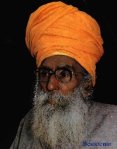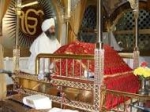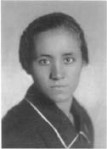How Ramji Das became Bhagat Puran Singh of Pingalwara Fame (4th June, 1904 – 5th August, 1992)
October 18, 2013
To start with let me explain to my readers what the word ‘Bhagat’ means.
This word is used for a person whose everyday deeds are ‘Su-Karma’ which means ‘Superior Deeds’. One can say that such a person has a pure soul and sees everyone as an embodiment of God. People observe his or her daily Karmas and automatically start calling such a person a ‘Bhagat’, meaning a fulltime devotee of God Almighty. But a wrong kind of deed can lower the prestige of such a person and people would automatically stop using the word ‘Bhagat’ for such a person.
Bhagat Puran Singh, the former Ramji Das, was in reality a born Saint. His Karma earned him the title of a ‘Bhagat’ from the public at large and he never faulted from the esteemed status. He didn’t have to wait for someone’s permission to do good deeds for the needy like Mother Teresa had to seek permission from her Church to start doing something for the downtrodden. Bhagat Puran Singh was a freelance ‘do-gooder’ who didn’t have to look over his shoulders for some religious institution to finance his efforts like Mother Teresa was assured financial support by the Church.
And let me caution my readers, before I go any further, that among the Punjabi business community there is a surname called ‘Bhagat’ which should not be assumed by the reader in the superior category: It is just another surname.
Ramji Das was born on 4th June, 1904 into a Hindu family in a small town called Rajewal or Rahon in Ludhiana district of Punjab, India. His father died of heart failure after hi money-lending business failed. To make both ends meet, Ramji Das’s mother worked as a servant in the house of a doctor in Sahiwal, now in Pakistan’s Punjab.
Despite her miserable condition she encouraged him to study up to the matriculation level (10th Standard) so that he could get one of the much sought after Government jobs. But his mind was not inclined to bookish studies and he failed to pass the Matriculation Examination. Instead he would spend hours browsing books in the Dyal Singh Library, Lahore searching for knowledge.
Then a miracle happened in the life of Ramji Das when he was still a young man. Once he had to go to some place and walking was the only option available to him due to his financial position. Motorized transportation -as one sees nowadays- did not exist in the rural areas at that time. Moreover, paved roads in the rural areas of Punjab and even in the rest of India, did not exist in those days. People either walked or they went by bullock carts or Raths (Ox driven Chariots) or on horseback: Only the rich could afford a horse or a Rath of their own.
After walking the whole day Ramji Das stopped at a village before sunset. There was no place to stay for the night as most villages did not have a Sarai (Inn) which were otherwise located at convenient distances on major highways only. The village he stopped at had a Mandir (Temple) and he went there with the hope to find shelter for the night. It was time for the evening Arti prayers and the priest asked him to take a broom and clean the courtyard of the Mandir, which he did.
After the Arti prayers, when it was time for dinner, the priest sat down in full view of Ramji Das and ate his meal. He had walked many miles and was very hungry but the priest had no considerations for a hungry man and threw the leftovers to a stray dog. Ramji Das had to spend the night on an empty stomach drinking water from a pot kept outside.
A few months after this unfortunate incident, Ramji Das was travelling in another direction when he stopped at a village with a Gurdwara (the door to the Guru) as the Sikh place of worship is called. He went there because he had heard that one could always find shelter and food at a Gurdwara.
It was time for the evening prayers and Ramji Das got thoroughly involved in doing Sewa, (selfless-service) without the Granthi having to ask him to do so. (Granthi is the person appointed to read the Sikh scripture called ‘Guru Granth Sahib’)
And what Ramji Das had often heard -one can always find shelter and food at a Gurdwara- actually happened to his pleasant surprise. When it was for dinner, the Granthi brought food for him in a Thali -the Indian metal plate. And when it was time to sleep he gave him a string cot which is commonly used in rural areas of Punjab. And the biggest surprise of all surprises, just when Ramji Das was falling asleep, the Granthi was there with a glass of hot milk and a piece of Gudd (Jaghari) which is traditionally taken with milk to help digestion.
Ramji Das went to sleep wondering about the vast difference in the moral and religious standards of the Indian society. Troubled thinking about the double standards of the Hindu priest he went to a Sant (Saint) in Lahore and narrated his unique experiences. The Sant is believed to have told him, after meditating upon the issue, that it was Gods’ calling and Ramji Das had to decide what he must do in life.
It didn’t take him long to make up his mind and he went to Gurdwara Dehra Sahib in Lahore, Pakistan. (This Gurdwara commemorates the spot where Guru Arjan Dev, the Fifth Guru of the Sikhs was martyred on 30th May, 1606 on orders of Mughal Emperor Jahangir) Ramji Das voluntarily went through the Amrit-pan ceremony (baptismal) for initiation into the Khalsa Panth, ‘The Universal Brotherhood of the Pure’ -the final and the highest level in the Sikh faith. At the end of the Amrit-pan ceremony Ramji Das adopted the name ‘Puran Singh’. Since ‘Singh’ meaning ‘Lion’ is suffixed to first names of all male volunteers joining the Khalsa Panth, the connotation in this case means ‘being lion-hearted and brave’. And he truly turned out to be lion-hearted and brave.
Puran Singh, the former Ramji Das, went through another transformation as if God Almighty had pre-programmed a noble-path for him. Since he was greatly inspired by the teachings of Guru Granth Sahib and the Sikh Gurus he continued to visit Gurdwara Dehra Sahib and did Sewa of many kinds: Stocking-up water near the entrance so that the Sangat (congregate of devotees to the Gurdwara) could wash their feet and clean up before entry; helping in the dairy of the Gurudwara’s Langar (kitchen); cleaning utensils in the Langar; making Rotis and serving food to the seated Sangat; sweeping and mopping the floors of the Gurdwara and doing any other service wherever and whenever needed.
One day, someone fell from the roof of the Gurdwara and was badly injured. Puran Singh immediately rushed him to the local hospital. Experiencing inner joy after helping him, Puran Singh took an old and abandoned man, whose leg was vermin-infected and badly bleeding, to a hospital. The man thanked Puran Singh saying, “Son! Now I can die peacefully.”
Due to this incident, service of humanity became the mission of Puran Singh’s life. He began to wander the lanes of Lahore looking for injured and physically handicapped people, taking them to hospitals with whatever money his pocket allowed. Once he even washed the clothes of an old beggar who was suffering from diarrhea.
On a moonless night in 1934, someone left a four year old child -a boy stricken with leprosy- at the door of the abovementioned Gurdwara Dehra Sahib. The then Head Granthi of the Gurdwara asked Puran Singh to keep an eye on the helpless child. Puran Singh named the child ‘Piara Singh’ meaning ‘the loved one’ and went a step further: Rather than pass the child over to the center for lepers he decided to care and raise him himself. He would carry Piara Singh on his back and go begging from door to door asking, “Give something for him and not for me.” This incident completely transformed his life. He then founded the famous Pingalwara (home for crippled, lepers and the destitute) in Lahore, now in Pakistan. Seeing his devotion people had already started calling him ‘Bhagat’ Puran Singh while he was still in Lahore.
After the partition on 14th-15th August 1947, when Pakistan became a separate country, the Pingalwara was shifted from Lahore to Amritsar, across the border. The idea for Pakistan to become a separate country was broached by the Muslim League party as a separate country for Indian Muslims. Once their demand was met and the new Country was demarcated, their thugs began ethnic cleansing -killing non-Muslims through well-planned assaults. With threat to their lives almost all Sikhs and Hindus left Pakistan and many Muslims crossed over from India: But all did not go across and some even came back to India to claim their ancestral homes. This conflagration, running into millions, created the largest human exodus in the world across any border killing in the process at least one million innocents besides shattering an age-old cordiality. It was an insensitive human calamity created by self-seeking politicians, both from the Indian National Congress and the Muslim League. The Sikhs were not keen that a separate country should be carved out along religious and ethnic line because they were not really concentrated in any particular region and were spread thinly all over having converted to Sikhism from both Hindus and Muslims during the previous 500 years.
As a result of this cross-border exodus, Bhagat Puran Singh reached Amritsar in 1947 to a camp with over 25 000 refugees. He found a large number of them critically wounded and incapable of nursing themselves. The situation had developed very suddenly and the Indian Government had not made plans for such a contingency. But Bhagat Puran Singh, being an evolved soul, took the initiative: With some chloroform and turpentine oil he started treating their wounds. He would often go into nearby neighborhoods to request people food and medicines for the needy.

Bhagat Puran Singh offering the last Ardas (prayer for the soul to rest in peace) for an abandoned patient
From 1947 till 1958, Bhagat Puran Singh did not have a permanent dwelling. He could be seen sitting outside the Golden Temple, the Chief Khalsa Diwan, Post Offices, Railway Stations and sitting under a tree outside the office of the local Civil Surgeon. He was all along urging people to donate to his noble mission, the Pingalwara. He would wander the streets asking for donations.
Subsequently the Pingalwara was registered as ‘The All India Pingalwara Charitable Society’ headquartered at Tehsilpura -a suburb of Amritsar- on Grand Trunk Road, the National Highway-1.
Bhagat Puran Singh died in 1992 but long after his death, the home he founded still tends the castaways of the society: The diseased, disabled, abandoned, forlorn, the poor, physically and mentally handicapped people. There is no discrimination by religion and no one is asked to convert to Sikhism unlike Christian Missionaries doing so. In fact, almost 95% inmates of the Pingalwara are of non-Sikh faith with no conditions whatsoever to change their faith.
The other uniqueness of Bhagat Puran Singh is that though he never finished his basic schooling, he became a writer, a (self) publisher, an environmentalist, and a philanthropist. A pioneer and an early advocate of what we today call the ‘Green Revolution’, Bhagat Puran Singh was spreading awareness about environmental pollution and the increasing soil erosion long before such ideas became popular. Pamphlets with his writings on various subjects, such as environmental awareness, were printed on re-used paper and freely distributed personally by him and his helpers.
Bhagat Puran Singh was honoured in 1979 by the Government of India with the Padma Shri award, given for exceptional and distinguished service in any field. But he was among the citizens of India who returned their awards and medals in protest after the Indian army’s avoidable attack on the Golden Temple in 1984. He peacefully expired on 5th August, 1992 at Amritsar due to old age -his mission was done and his time had come. By the time he left for his heavenly abode he had served the needy for over 60 years starting much before 1934 when he first carried the four year old leprosy stricken child on his back.
Bhagat Puran Singh was nominated for the Nobel Peace Prize in 1991 –a year before his death- for his selfless work: Feeding, clothing, tending the sick and dying people. But he was never given this world famous prestigious award even though he had served for more than 60 years with serious financial limitations and with whatever money the general public would donate.
Compare this disparity to Mother Teresa, who, by the time she was awarded the Nobel Peace Prize in 1979 had served the needy for 29 or 30 years only -establishing her ‘Missionaries of Charity’ on 7th October, 1950 under financial protection of the Church.
I have nothing say against Mother Teresa: I am trying to point out the double standards of people who decide who did a greater deed.
What could be the reason for this obvious disparity?
1. Was it because Bhagat Puran Singh was not a Christian?
2. Was it because he came from a developing country and was not from Europe?
3. Was it that the Nobel Committee found this turban wearing maverick out of place?
4. Was it because he had not travelled far and wide by fancy jetliners and not met prominent international personalities like Jet-Set Mother Teresa had done? She was a frequent international traveler meeting prominent world personalities. An international exposure obviously helps in networking and fund raising.
5. On the contrary to move around within Amritsar, Bhagat Puran Singh peddled his personal three-wheeled Cycle-Rikshaw, the cheapest taxi in India. And he travelled by buses and trains even when he had to visit New Delhi to receive his Padma Shri award from the Indian Government.
6. Perhaps, the Nobel Committee had not been able to objectively compare the vast difference in the circumstances under which Bhagat Puran Singh and Mother Teresa worked. This may have happened because whoever presented the proposal to the Nobel Committee had not, probably, highlighted the significant differences in their work environments.
In my humble opinion, Bhagat Puran Singh’s work had been of Greater Significance than Mother Teresa’s!
Bhagat Puran Singh’s selfless service was of greater significance than Mother Teresa’s. Yet when she died even the President of India went for her funeral with much media hype whereas Bhagat Puran Singh’s death went almost unnoticed at the national level. If the President of India went for her funeral, because he was a Christian himself, then he should have gone in his personal capacity not using the National facilities and the media should have reported it accordingly. And there were prominent politicians hunting for Christian votes.
Shame on the so-called Great Hindu Culture! For a foreign missionary to come and to do what Mother Teresa did in Calcutta, it’s a blot on the so-called ‘Great Hindu Culture’: But it’s not surprising. It was because of the selfishness of the Brahmins in general which changed Ramji Das to Bhagat Puran Singh. And then the right-wing diehards Hindus cry foul when some people get converted to Christianity.
Bhagat Puran Singh chair:- Bhagat Puran Singh Chair for Studies in Selfless Service to Humanity was established at Guru Nanak Dev University, Amritsar in 2005. Objective of this chair is to highlight the contributions of Bhagat Puran Singh in the betterment of our society and how his philosophy can be used for a healthy and prosperous future. After his demise Dr. Bibi Inderjit Kaur is the present head of the Pingalwara.

Five Rupees Commemorative postage stamp by Ministry of Communications and Information Technology 2004
Stamp on Bhagat Puran Singh
A Rupee Five Commemorative postage stamp on Bhagat Puran Singh was released by the Ministry of Communication & Information Technology in 2004 paying tribute to a great self-regulated personality.



















